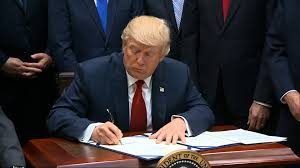
U.S. Senator Jim Inhofe (R-OK), chairman of the Senate Environment and Public Works Subcommittee on Transportation and Infrastructure, John Barrasso (R-WY), chairman of the Senate Committee on Environment and Public Works (EPW), committee ranking member Tom Carper (D-DE) and Transportation and Infrastructure Subcommittee ranking member Ben Cardin (D-MD) released the following statements on President Trump signing S. 3021, America’s Water Infrastructure Act into law.
America’s Water Infrastructure Act is one of the most sweeping infrastructure bills to be considered this Congress. It grows the economy, keeps communities safe, cuts red tape and is fiscally responsible. The bipartisan legislation passed the Senate by a vote of 99 to 1. The House of Representatives passed the legislation by voice vote. For more information on the legislation, click here.
“The overwhelming bipartisan passage of the America’s Water Infrastructure Act demonstrates what the Republican majorities in Congress can get done with President Trump,” said Inhofe. “Just look at Oklahoma. With President Trump’s signature today, state and local stakeholders will have a greater say in which projects get funded, assurances that their projects will move forward—like key projects in Altus, Midwest City, and Three Rivers that supports the MKARNS—and the city of Bartlesville will have certainty in water storage pricing. I’m proud that we kept our commitment to biennial water resources bills and applaud President Trump for signing America’s Water Infrastructure Act today.”
“I applaud President Trump for signing this significant piece of infrastructure legislation into law,” said Barrasso. “The president called on Congress to act and America’s Water Infrastructure Act delivers. The bipartisan bill will keep communities safe and cut red tape, all while being fiscally responsible. It is good for Wyoming and good for the nation. America’s Water Infrastructure Act will upgrade and maintain aging dams and irrigation systems, increase water storage, and deepen nationally significant ports. It authorizes funds to repair aging drinking water systems, so that communities across America have access to clean drinking water. It authorizes important projects that will create jobs and grow our economy. America’s Water Infrastructure Act is a win for all Americans, and I am pleased the president has signed it into law.”
“I’m proud that the only bipartisan and bicameral infrastructure bill of this Congress, which I co-authored along with Chairman Barrasso, is being signed into law today,” said Carper. “It delivers for all Americans by making smart investments in critical water infrastructure that every family in every state rely on, such as drinking water systems, dams, reservoirs, levees, and ports. This bill creates a nurturing environment for good-paying jobs, incentivizes businesses to buy and use American products, and authorizes funding for EPA to expand investments in clean drinking water for the first time in more than two decades. Today is a testament to the fact that, in order to get meaningful legislation across the finish line, you have to be willing to consider ideas from all sides. I’m pleased to have seen this process through from the very start, and glad that this bill is finally becoming the law of the land.”
“Passage of America’s Water Infrastructure Act punctuates the strong bipartisan support for repairing and maintaining our nation’s waterways and infrastructure,” said Cardin. “Marylanders, and communities nationwide, will greatly benefit from how we have been able to work together to ensure the safety and resiliency of our waterways and water systems.”
America’s Water Infrastructure Act will:
· Authorize federal funding for water infrastructure projects, which leverages billions in water infrastructure spending;
· Expand water storage capabilities;
· Deauthorize billions of dollars in unneeded spending and reduce the deficit;
· Assist local communities in complying with the Safe Drinking Water Act and Clean Water Act by upgrading aging drinking water, wastewater and irrigation systems;
· Reduce flooding risks for rural, western, and coastal communities;
· Ensure that America maintains the competitiveness of our coastal and inland ports, and maintain the navigability of our inland waterways;
· Create a new framework to allow for more Army Corps projects to be budgeted with increased local stakeholder input and expanded transparency;
· Authorize or reauthorize important water infrastructure programs and projects; and
· Address significant water infrastructure needs in tribal communities.
Read the text of America’s Water Infrastructure Act here and a section-by-section of the legislation here.





